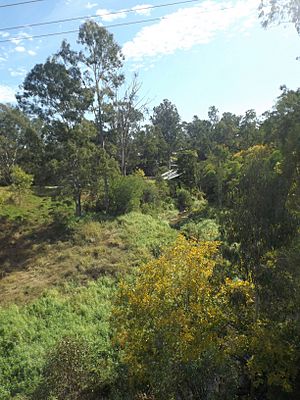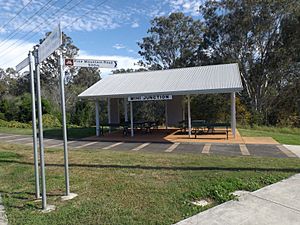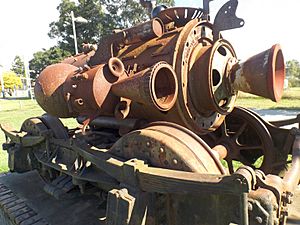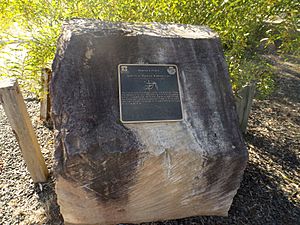Mihi Creek heritage site facts for kids
Quick facts for kids Mihi Creek heritage site |
|
|---|---|

Mihi Creek, 2015
|
|
| Location | Mihi Junction, Brassall, City of Ipswich, Queensland, Australia |
| Official name: Mihi Creek Complex, Mihi Junction, Mi Hi Creek | |
| Type | archaeological |
| Designated | 16 July 2010 |
| Reference no. | 645610 |
| Significant period | 1865 - c.1960 |
| Significant components | embankment - railway, machinery/plant/equipment - mining/mineral processing, formation - railway, culvert - railway, pile/s, coke oven, cutting - railway |
| Lua error in Module:Location_map at line 420: attempt to index field 'wikibase' (a nil value). | |
The Mihi Creek heritage site is a special historical place in Brassall, City of Ipswich, Queensland, Australia. It's known for its old railway parts and coal mining history. This site is also called Mihi Junction or Mi Hi Creek. It was added to the Queensland Heritage Register on 16 July 2010 because of its important past.
Contents
A Look Back in Time
The Mihi Creek site is like a living history book. It shows how people used the land from the early 1860s until about 1960. This area has two main historical stories. First, it was used for Queensland's very first main railway line. Later, it became a busy place for coal mining and making coke.
Queensland's First Railway (1865 - 1875)
In the early days, Queensland's government really wanted to build railways. They believed trains would help the state grow. Trains would make it cheaper to move goods and faster for people to travel. Roads back then were often very bad, especially when it rained. This made it hard to transport anything.
Ipswich was chosen as the starting point for the first main railway. It was an important port city for farmers from the Darling Downs region. Ipswich was also a key meeting point for transport routes.
The main engineer for the railway was Abraham Fitzgibbon. An English company, Charles Fox and Son, helped with the plans. A company called Peto, Brassey and Betts, which had built railways all over the world, was hired to construct the line.
Building started on 25 February 1864. The first section of the railway went from Ipswich to Bigge's Camp (now Grandchester). The line officially opened on 31 July 1865.
The first bridge over Mihi Creek was one of four bridges on this new line. But the railway track near Mihi Creek had problems. It was too close to the Bremer River and Mihi Creek. After a flood in 1867, the ground started to sink. The curves in the track leading to the bridge were also very sharp.
So, in May 1868, a new section of track was built. This "Mihi deviation" crossed the creek higher up, away from floods. It also had gentler curves. The old track and bridge were removed.
The original line was used until 1875. Then, a new railway line was opened south of the Bremer River. This new line bypassed the first six kilometers of the old track. However, a part of the old line was kept. It was used to serve the North Ipswich Railway Workshops and the coal mines at Mihi Creek.
Coal Mining and Coke Making (1864 - c.1960)
Coal was first found in Queensland in 1825. It was one of the first minerals mined for money in Queensland. Mining started in Goodna in 1843. The West Moreton Coalfield in Ipswich began in the early 1850s.
Coke is a special fuel made from coal. It's created by baking coal in very hot ovens. Coke is used as a fuel and also to help melt metal ores. It became very important from the late 1860s. This was when steam-powered ships and trains needed a lot of fuel. Coke-making sites were often built near transport, like roads, railways, or rivers.
In 1871, the Eastwood Mine opened at Mihi Creek. It was named after its owner, John Eastwood. This mine was active through the 1870s and early 1880s. Later, it was sold and renamed the Mihi Mine in 1884. A short railway track was built to connect the mine to the main Ipswich railway line.
Soon after, twelve coke ovens were built on the hillside above Mihi Creek. These were called the Mihi Ovens. They were "beehive type" ovens, named for their dome shape. They were usually built in rows, like batteries. The Mihi Ovens were used until about 1890.
The site was mined again in 1908 by Paul Francis. He called his mine the Francis Mine. He used a horse-powered machine to pull coal out of the tunnels. He also built storage bunkers for the coal. In 1917, another tunnel was dug.
In 1923, the site was sold and became Klondyke Collieries Limited. Under this company, coke production really grew. They replaced the horse machine with an electric one. They also added equipment to sort and crush the coal.
The ovens were used throughout the 1930s. By 1942, more beehive ovens were built to meet the demand for coke. During the 1940s, Klondyke was one of only two coke producers in Queensland.
In 1948, the site changed owners again and was called Moreton Colliery. It operated until the early 1950s when the coal ran out. Some people remember the ovens still being used as late as 1960. After this site closed, coke production moved to the nearby Haighmoor site.
What You Can See Today
The Mihi Creek heritage site is in North Ipswich. It's a grassy area that slopes down to the Bremer River. You can still see signs of the old coke-making operations. These are mostly north of Mihi Creek. The remains of the railway are on both sides of the creek.
The old railway tracks are visible as raised earth banks, called railway embankments. There are two sets of these banks. One is from the original 1864 railway line. The other is from the newer 1867-68 line. They both curve along the river bank.
The larger embankment, from 1867-68, has a gentler curve. These banks end at steep slopes on either side of Mihi Creek. This is where the bridge supports used to be. On the western side, the banks are easy to see. On the eastern side, they blend more with the ground. You can also see sandstone blocks at the top of the banks.
Some broken bridge piles from the 1867-68 bridge are still in the bed of Mihi Creek. These piles had sharp ends reinforced with iron. This matches the original bridge plans.
You can also find cut sandstone blocks from the 1864-65 bridge. There might also be a buried sandstone culvert (a tunnel for water) from the 1864 line. This culvert is shown on old railway maps. Similar culverts still exist nearby.
The first group of beehive ovens, called the "Mihi Ovens," are located north and west of the Klondyke Coke Ovens. These ovens were built around 1884. The entrances of three of these ovens are partly visible on a slope. We don't know the full size of these ovens, but there were likely 12 of them.
Near the ovens, there are two small brick structures. Their purpose is unknown. One might have been a ventilation shaft for a mine tunnel. The area around the ovens has been cleared of plants and fenced off to protect them.
You can also see a short section of old railway track. This might be a side track built between 1884 and 1890. It would have served the coke ovens. A small bridge, possibly for trolleys, is now used as a pedestrian bridge.
Around the site, you'll find lots of brick pieces, coal, and coke. There are also metal parts from old machinery. These include parts of skips, crushing machines, and conveyor belts. All these bits and pieces tell the story of the site's past.
Why This Site is Important
The Mihi Creek site was added to the Queensland Heritage Register on 16 July 2010. It's important for several reasons:
- Early Development: The site has physical evidence and more hidden evidence about the early growth of the Ipswich area. It shows us about Queensland's first main railway, early coal mining, and coke making.
- Rare Railway History: The old railway parts are rare. They show how important it was to develop the Ipswich region when Queensland was a young colony. The railway was built to make transport faster and cheaper.
- Important Industries: The remains of coal mining and coke making show important industries in Queensland's history. Coke making was a vital but often overlooked part of coal mining for a long time, from the 1870s to about 1960. The site shows how coke was made for early Queensland industries, like trains and ships.
- Research Potential: Studying the Mihi Creek site can help us learn more about how railways were built in the late 1800s. It can also teach us about Queensland's coke manufacturing industry from the late 1800s to the early 1900s.
- Unique Information: There aren't many old written records about coke making in Queensland. This means the physical evidence at Mihi Creek is very important. It can help us understand how coke was made, what equipment was used, and how the industry changed over time.
- Long History: The coal and coking operations at Mihi Creek lasted a long time (1870s - c.1960). They also changed owners and methods over the years. Studying this site can reveal important details about the specific operations at Mihi Creek. It can also show how coal mining and coke making changed in the West Moreton Coalfield and across Queensland.




